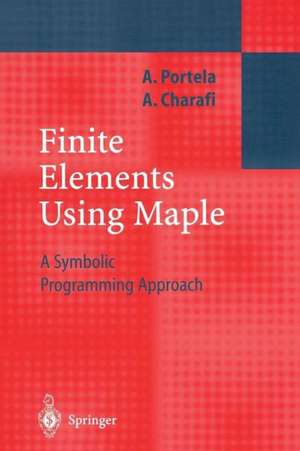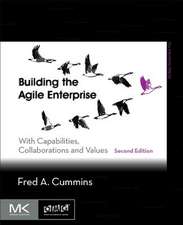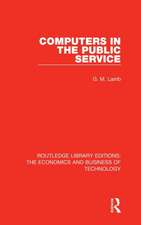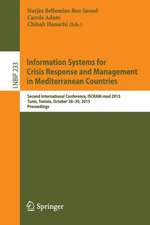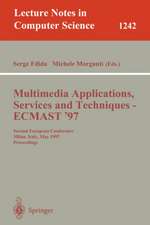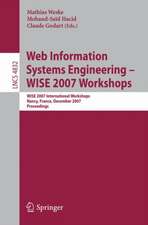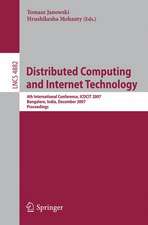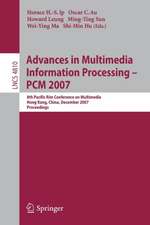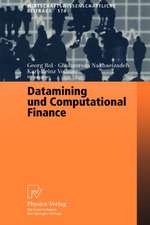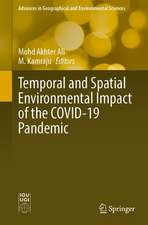Finite Elements Using Maple: A Symbolic Programming Approach
Autor Artur Portela, A. Charafien Limba Engleză Paperback – 27 oct 2012
| Toate formatele și edițiile | Preț | Express |
|---|---|---|
| Paperback (1) | 334.71 lei 6-8 săpt. | |
| Springer Berlin, Heidelberg – 27 oct 2012 | 334.71 lei 6-8 săpt. | |
| Hardback (1) | 340.98 lei 6-8 săpt. | |
| Springer Berlin, Heidelberg – 26 feb 2002 | 340.98 lei 6-8 săpt. |
Preț: 334.71 lei
Preț vechi: 418.38 lei
-20% Nou
Puncte Express: 502
Preț estimativ în valută:
64.05€ • 67.18$ • 53.32£
64.05€ • 67.18$ • 53.32£
Carte tipărită la comandă
Livrare economică 01-15 aprilie
Preluare comenzi: 021 569.72.76
Specificații
ISBN-13: 9783642627552
ISBN-10: 3642627552
Pagini: 344
Ilustrații: XV, 326 p.
Dimensiuni: 155 x 235 x 18 mm
Greutate: 0.48 kg
Ediția:Softcover reprint of the original 1st ed. 2002
Editura: Springer Berlin, Heidelberg
Colecția Springer
Locul publicării:Berlin, Heidelberg, Germany
ISBN-10: 3642627552
Pagini: 344
Ilustrații: XV, 326 p.
Dimensiuni: 155 x 235 x 18 mm
Greutate: 0.48 kg
Ediția:Softcover reprint of the original 1st ed. 2002
Editura: Springer Berlin, Heidelberg
Colecția Springer
Locul publicării:Berlin, Heidelberg, Germany
Public țintă
GraduateCuprins
1. Introduction to Maple.- 1.1 Basics.- 1.2 Entering Commands.- 1.3 Fundamental Data Types.- 1.4 Mathematical Functions.- 1.5 Names.- 1.6 Basic Types of Maple Objects.- 1.7 Evaluation Rules.- 1.8 Algebraic Equations.- 1.9 Differentiation and Integration.- 1.10 Solving Differential Equations.- 1.11 Expression Manipulation.- 1.12 Basic Programming Constructs.- 1.13 Functions, Procedures and Modules.- 1.14 Maple’s Organization.- 1.15 Linear Algebra Computations.- 1.16 Graphics.- 1.17 Plotter: Package for Finite Element Graphics.- 2. Computational Mechanics.- 2.1 Introduction.- 2.2 Mathematical Modelling of Physical Systems.- 2.3 Continuous Models.- 2.4 Mathematical Analysis.- 2.5 Approximation Methods.- 2.6 Discrete Models.- 2.7 Structural Models.- 3. Approximation Methods.- 3.1 Introduction.- 3.2 Residuals.- 3.3 Weighted-Residual Equation.- 3.4 Approximation Functions.- 3.5 Admissibility Conditions.- 3.6 Global Indirect Discretization.- 3.7 Integration by Parts.- 3.8 Local Direct Discretization.- 4. Interpolation.- 4.1 Introduction.- 4.2 Globally Defined Functions.- 4.3 Piecewisely Defined Functions.- 4.4 Finite Element Generalized Coordinates.- 4.5 Finite Element Shape Functions.- 4.6 Parametric Finite Elements.- 4.7 Isoparametric Finite Elements.- 4.8 Linear Triangular Isoparametric Element.- 5. The Finite Element Method.- 5.1 Introduction.- 5.2 Steady-State Models with Scalar Variable.- 5.3 Finite Element Mesh.- 5.4 Local Finite Element Equations.- 5.5 Global Finite Element Equations.- 5.6 Exact Boundary Conditions.- 5.7 Solution of the System of Equations.- 5.8 Computation of Derivatives.- 5.9 Finite Element Pre- and Post- Processing.- 5.10 Cgt-fem: Package for Finite Element Analysis.- 5.11 Example.- 5.12 Example.- 5.13 Example.- 5.14 Example.- 6. Fluid MechanicsApplications.- 6.1 Introduction.- 6.2 Continuous Models of Fluid Flow.- 6.3 Confined Flows.- 6.4 Unconfined Flows.- 6.5 Groundwater Flows.- 6.6 Example.- 6.7 Example.- 7. Solid Mechanics Applications.- 7.1 Introduction.- 7.2 Continuous Models.- 7.3 Fundamental Continuous Model: Elasticity Theory.- 7.4 Finite Element Model.- 7.5 Mesh Topology.- 7.6 Constrained Displacements.- 7.7 Application of the Finite Element Model.- 7.8 Three-Dimensional Equilibrium States.- 7.9 Two-Dimensional Equilibrium States.- 7.10 One-Dimensional Equilibrium States.- 7.11 Further Study.
Recenzii
From the reviews:
"The purpose of this book is to illustrate how the computational environment of Maple can be used in a finite element … . It gives to the reader a very unique insight into the finite element method together with symbolic programming approach … . In summary, this book is an excellent introductory book for finite element method and I strongly recommend to all undergraduate and postgraduate students and also to engineers and scientists who wish to program easily the finite element method." (T.E. Simos, Journal of Computational Methods in Sciences and Engineering, Vol. 3 (2), 2003)
"This book is an essential tool written to be used as the primary text for an undergraduate or early postgraduate course as well as a reference book for engineers and scientists who want to develop quickly finite-element programs." (European Journal of Mechanical and Environmental Engineering, Vol. 47 (2), 2002)
"The purpose of this book is to illustrate how the computational environment of Maple can be used in a finite element … . It gives to the reader a very unique insight into the finite element method together with symbolic programming approach … . In summary, this book is an excellent introductory book for finite element method and I strongly recommend to all undergraduate and postgraduate students and also to engineers and scientists who wish to program easily the finite element method." (T.E. Simos, Journal of Computational Methods in Sciences and Engineering, Vol. 3 (2), 2003)
"This book is an essential tool written to be used as the primary text for an undergraduate or early postgraduate course as well as a reference book for engineers and scientists who want to develop quickly finite-element programs." (European Journal of Mechanical and Environmental Engineering, Vol. 47 (2), 2002)
Textul de pe ultima copertă
Providing the user with a unique insight into the finite element method, along with symbolic programming that fundamentally changes the way applications can be developed, this book is an essential tool for undergraduate or early postgraduate course, as well as a reference book for engineers and scientists who want to develop quickly finite-element programs. The use of symbolic computation in Maple system delivers new benefits in the analysis and understanding of The finite element method.
Caracteristici
Introduces a new, more systematic approach to Finite Element Analysis using Symbolic Computation Can be a primary text for an undergraduate or early postgraduate course, as well as a reference book for engineers and scientists
